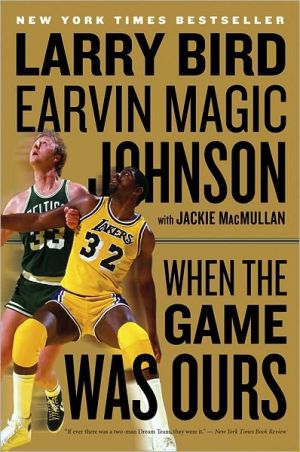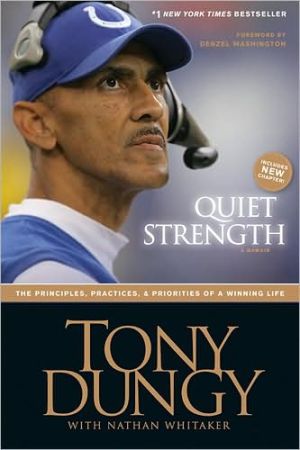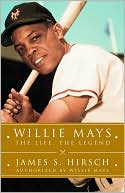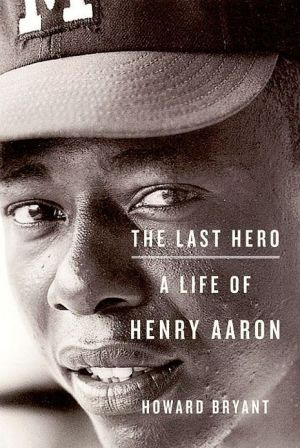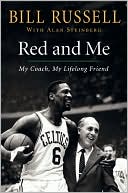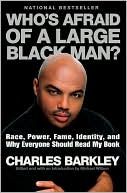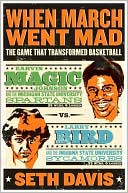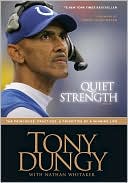When the Game Was Ours
A riveting portrait of two legendary players whose fierce rivalry came to define one of the most exciting periods of professional basketball\ In Celtic green was Larry Bird, the hick from French Lick with laser-beam focus, relentless determination, and a deadly jump shot—a player who demanded excellence from everyone around him and whose caustic wit left opponents quaking in their high-tops. Magic Johnson was Mr. Showtime: young, indomitable, a magnetic personality with all the right moves,...
Search in google:
From the moment these two legendary players took the court on opposing sides, they engaged in a fierce physical and psychological battle. In Celtic green was Larry Bird, the hick from French Lick, with laser-beam focus, relentless determination, and a deadly jump shot, a player who demanded excellence from everyone around him and whose caustic wit left opponents quaking in their high-tops. Magic Johnson was Mr. Showtime, a magnetic personality with all the right moves. Young, indomitable, he was a pied piper in purple and gold. And he burned with an inextinguishable desire to win. Their uncommonly competitive relationship came to symbolize the most thrilling rivalry in the NBA—East vs. West, physical vs. finesse, old school vs. Showtime, even white vs. black. Each pushed the other to greatness, and together Bird and Johnson collected eight NBA Championships and six MVP awards, helping to save a floundering NBA. At the start they were bitter rivals, but along the way they became lifelong friends. With intimate detail, When the Game Was Ours transports readers to an electric era and reveals for the first time the inner workings of two players dead set on besting each other. It is a compelling portrait of two giants of the game, during professional basketball’s best times.The Washington Post - Dave SheininPerhaps more than any other sports rivals (with the possible exception of boxers Muhammad Ali and Joe Frazier), Bird and Magic are intertwined in history, and that rivalry and that history (as well as the friendship, both unlikely and unavoidable, that developed between them) are at the heart of a fascinating new book, When the Game Was Ours. Though Bird and Johnson (with Jackie MacMullan) are credited as the authors, it is clearly MacMullan's book, as all but the introduction (by Bird and Johnson) is written in the third person, with the former Boston Globe reporter and columnist masterfully weaving the recollections of the two protagonists with those of dozens of observers, including teammates and family members.
APRIL 9, 1978\ Lexington, Kentucky The errant shot came off the glass at a sharp angle, but Larry Bird, charting the flight of the ball, pulled down the rebound and advanced without hesitation, swiveling his head as he examined his options.\ Earvin Johnson had already begun to head down the court the moment the ball was in flight. He’d been playing with Bird for only six days on a team of college All-Stars in this international roundrobin competition, yet already Johnson had determined that Bird was the most resourceful rebounder they had.\ Bird filled the center lane, and Magic streaked down the right side, calling for the ball, but the forward looked away, as if he had pressing matters elsewhere. For one brief instant, Magic was disappointed. “I guess he’s not going to give it to me,” he murmured.\ And that’s when it came: a behind-the-back missile that landed directly on Magic’s right palm. It remained there just long enough for Johnson to disarm defender Andrei Lapatov with a crossover dribble, then sling it back over his shoulder with a no-look feed to Bird.\ Indiana State’s star barely aligned the seams before his touch pass was back to Magic, leaving no time for the overmatched Soviet player to react. As Johnson banked in the lay-up, the crowd at Rupp Arena in Lexington, Kentucky, roared with delight.\ Magic turned and charged toward Bird to offer him his signature high-five. Bird slapped the teenager’s hand, and the two jogged back down the floor, side by side, one skipping, clapping, and celebrating as he went, the other, head down, expressionless, as if nothing remarkable had occurred.\ The intertwined basketball journey of Earvin “Magic” Johnson and Larry “Joe” Bird had officially begun—as teammates.\ Johnson had never met Bird before the tournament. He was stunned at how well the forward passed the ball, and when Bird fed him the no-look pass, Magic told himself, “I’m not going to let this guy upstage me.”\ “It was an incredible three seconds of basketball,” Magic said. “It was boom, boom, boom! I’m thinking, ‘Man, I love playing with this guy!’ And believe me, the crowd loved it too.”\ Some thirty years after that collaborative transition basket, executed against the Soviet Union’s national team when Magic was just 18 years old and Bird only 21, both remember the play with startling clarity.\ “The defender was stumbling to keep up with us,” Bird recalled. “We were coming at him so fast that his head was going around and around, and he ended up in a circle. I was sort of laughing, because the poor kid didn’t have a clue.”\ He wasn’t the only one. No one thought to chronicle the footage of Bird and Magic’s wizardry in the open floor. There were no breathless descriptions of the artful passers in the morning papers. In 1978, though both had displayed a developing basketball pedigree, they were not widely recognized as elite players. At that juncture, neither had won an NBA championship, a league MVP, or, for that matter, an NCAA title. The irony of Bird and Magic commencing their storied relationship as teammates did not register because their parallel careers had not yet evolved into one of the compelling rivalries in basketball history.\ “They were certainly good,” noted Michael O’Koren, their tournament teammate, “but they weren’t Magic and Larry—not yet.”\ Instead, Johnson and Bird were second-stringers on an amateur basketball team participating in an international round-robin competition called the World Invitational Tournament, or WIT, attempting in vain to prove to the coach, Joe B. Hall, they were worthy of prime-time minutes.\ Although Bird and Magic occasionally shared knowing glances when the two of them outwitted the starters in practice, Bird revealed little of himself to Johnson. He was a young man of few words—until he went back home to French Lick, Indiana, and tracked down his brother, Mark Bird.\ “I’ve just seen the best player in college basketball,” Larry gushed. “It’s Magic Johnson.” ### The World Invitational Tournament was a whirlwind, made-for-television event that assembled a group of top college players and held three games in five days against the Soviets, Cuba, and Yugoslavia at rotating venues: the Omni in Atlanta, Carmichael Auditorium on the campus of North Carolina, and Rupp Arena in Lexington.\ Bird had just completed his junior season at Indiana State as a first-team All-America selection who would be drafted by the Boston Celtics within the next three months. Magic had just finished his first year at Michigan State, a third-team All-America pick who had dazzled the Big Ten with his array of no-look feeds, alley-oops, and backdoor bounce passes.\ Yet, on the World Invitational team, also known as the Converse Cup, Johnson and Bird were afterthoughts. The headliners were Joe B. Hall and his Kentucky Wildcats, who had beaten Duke 94 88 the previous week to capture the NCAA championship. Coach Hall placed five of his guys on the WIT roster: swingman Jack “Goose” Givens, who had poured in 41 points in the title game against Duke; Rick Robey, their rugged big man; point guard Kyle Macy; lefty forward James Lee; and guard Jay Shidler.\ Givens, Macy, and Robey garnered most of the minutes in the tournament even though the second team, anchored by Johnson and Bird, dominated them in practice. Privately, both players fumed as they sat and watched inferior players gobble up their minutes.\ “There were the Kentucky players, and the rest of us were fillers,” Bird said. “Hall wanted to go around the country and show off his guys.”\ Bird and Magic spent a total of eight days together during the WIT. They engaged in no more than four or five conversations, even though they ate together, practiced together, and rode the bus together. While Magic hobnobbed with Arkansas star Sidney Moncrief, blasting his boom box and jiving to the beat of the Ohio Players, Bird remained largely to himself, surveying the Kentucky scenery out the bus window while Magic’s music—and personality—overtook the team.\ “Magic was nonstop chatter,” said Rutgers star James Bailey. “And Larry said zero. It was ‘Good morning,’ and don’t expect a lot more.”\ The World Invitational Tournament was the concoction of television executive Eddie Einhorn. While professional basketball in the 1970s produced dismal ratings, the colleges, provided the matchups had some national appeal, were proving to be a market with potential.\ Einhorn had already successfully televised exhibition games against Russians and felt that a competition with some international flavor would prove to be successful. Thus, the WIT was born.\ Einhorn enlisted the help of Brandeis athletic director Dick Rodis and Providence College basketball coach Dave Gavitt, prominent members of the Amateur Basketball Association of the United States (later renamed USA Basketball), to fill out the roster around the Kentucky players.\ “At that time, I really didn’t even know who Magic and Larry were,” Einhorn admitted. “I would venture to say most other people didn’t either.”\ Gavitt was painfully aware of the abilities of Michigan State’s imposing point guard. Just weeks earlier, Magic and his Spartans had steamrolled Gavitt’s Providence Friars in the opening round of the 1978 NCAA Mideast Regional in Indianapolis. Magic scored 14 points and dished out 7 assists, but his ability to push tempo and provide his teammates with high-percentage shots (Michigan State hit 61 percent of its field goals) was what caught Gavitt’s eye. Johnson saw the game differently than the other players, almost as if he were watching the action unfold in slow motion.\ Bird’s Indiana State team posted a 239 mark that spring but was left out of the NCAA field, relegated instead to the less prestigious NIT tournament. Gavitt had never seen him play and knew little about him. Since Indiana State was not being featured on network television, many basketball fans assumed Bird was African American.\ Boston Globe writer Bob Ryan hadn’t seen Larry yet either, but was already well versed in Bird lore. Ryan was in Indianapolis to cover Providence but informed Gavitt he also was driving to Terre Haute to check out the Sycamores and this mysterious hidden gem, whom Celtics scouts assured him was a legitimate NBA prospect.\ Ryan embarked on his pilgrimage with Providence Journal sportswriters Mike Madden and Jayson Stark, who were openly skeptical of Bird’s credentials. He was playing at a small school in a small conference, which, they surmised, accounted for his prolific offensive numbers.\ The writers barely had time to remove their jackets before the right-handed Bird snared a rebound and started up the left side of the floor dribbling left-handed. Just shy of midcourt, he fired an underhand rocket pass to his guard off the dribble for a lay-up.\ “From that moment on, I was hooked,” said Ryan.\ Indiana State went on to win by a point on a jumper by Bird. Ryan was so animated talking about his performance on the way back to Indianapolis, he was driving 75 miles per hour when the state police pulled him over.\ “Sorry,” Ryan told the trooper. “I’m just excited because I’m coming back from the ISU game.”\ “Oh, yeah?” said the cop, ripping up the ticket. “Who won?”\ The next morning the scribes were back court-side in Indianapolis to witness another legend in the making: a 6-foot- 8 (and growing) floor general who dominated play without a consistent jump shot. Magic was a whirling dervish of energy and enthusiasm. Even though he was just a freshman, he barked orders to his older teammates and after every successful play slapped hands, whooped, and celebrated with his teammates. The Friars players took offense at his histrionics, particularly in light of the lopsided score (7763).\ “Some people thought he was a hot dog,” Gavitt said. “I never did. He played like he loved the game. There was a lot of high-fives and fist-pumping, which you didn’t see a whole lot of back then.\ “I suppose it was annoying if you were on the other team. I asked his coach, Jud Heathcote, about it, and he said, ‘Dave, he’s like that every day in practice. Not some days—every day.’”\ After Gavitt met with the press and gave proper credit to Michigan State and their remarkable blossoming star, he bumped into Bob Ryan in the hallway.\ “So, how did your ‘hidden gem’ do in Terre Haute?” he asked.\ “Dave,” Ryan answered, “I just saw one of the game’s next great players.”\ When it came time to flush out the World Invitational team roster, Gavitt recalled Ryan’s endorsement and added both Magic and Bird to his list.\ Bird was ecstatic about being chosen, until he learned the identity of the coach. Joe B. Hall recruited Bird out of Springs Valley High School in French Lick, Indiana, but after watching him, Hall determined that Bird was “too slow” to play Division 1 basketball. A wounded Bird vowed to prove him wrong someday and was disappointed that he never had the opportunity to play against Kentucky in college.\ “I wanted a crack at that guy,” Bird said.\ The odds of that happening were slim. Kentucky was one of the more prestigious programs in the country. Their conference, the Southeastern, was known primarily as a football hotbed, with heavyweights Alabama, Auburn, Florida, and Georgia among its members. The Wildcats, under the tutelage of Adolph Rupp, had established themselves as one of the top basketball powers in the country in the late 1940s, winning four NCAA championships in ten years. Indiana State simply didn’t measure up, and neither did Michigan State—at least not until students named Earvin and Larry arrived on their respective campuses and instantly altered the basketball landscape.
\ From Barnes & NobleConsider the matchup: Larry Bird; 13 seasons with Boston Celtics; 3 NBA titles; 3 MVP awards; Rookie of the Year; Olympic Gold Medal; Basketball Hall of Fame. "Magic" Johnson; 13 seasons with the Los Angeles Lakes; 5 NBA titles; 3 MVP awards; Olympic Gold Medal; Basketball Hall of Fame. The high-flying, one-on-one competition between these two behemoths generated excitement far beyond their arenas. Their friendly rivalry and the fierce competition between their teams sparked a pro basketball renaissance. In When The Game Was Ours, these two giants of the sport reveal the inner stories of their longstanding hoop struggles. High adrenaline excitement. Now in paperback.\ \ \ \ \ \ From the Publisher“MAGICBIRD, BIRDMAGIC really should be the titled “When the Game was Mine” because that is how they went after each other on the court. In When the Game Was Ours you will enjoy an exhilarating ride down one of the most competitive rivalries ever.”\ —Pat Riley\ \ "Finally—a book that tells the story of Magic and Larry from their vantage point. When the Game Was Ours took me inside their fascinating rivalry with new insights and revealing details about two men who evolved from bitter competitors into lifelong friends."\ —Denzel Washington \ "At long last the great book on Bird and Magic—their own account, told from behind the scenes, inside huddles, confidential phone conversations, backseats of cars, and most importantly, from their inner hearts. Their book is alive with truth—it's a story of brilliance, brilliantly told with the help of prize-winning writer Jackie MacMullan."\ —Sally Jenkins , author of The Real All Americans, Funny Cide, and It’s Not About the Bike with Lance Armstrong\ \ "When The Game Was Ours is the ultimate insiders' account of the rivalry, the friendship, the tension and the bond between Bird and Magic that launched the modern NBA. A real treat for all hoops fans."\ —Tom Verducci , author with Joe Torre of the #1 New York Times bestseller, The Yankee Years\ \ "You know that game where you pick a certain number of characters for your favorite dinner party of all time? (The one where you picked Gandhi, Babe Ruth, Li'l Wayne and, who was it, Jenna Jameson?) I just spent a couple of nights with Larry Bird and Magic Johnson in the lyrical When The Game Was Ours and they should be in the mix. They're funny, frank, anecdotal and just plain interesting. This book is terrific."\ —Leigh Montville , bestselling author of Ted Williams and The Big Bam\ \ "Unprecedented insight and commentary from the stars themselves on their unique relationship, a compelling mixture of bitter rivalry and mutual admiration... Offers a captivating look at the NBA’s greatest era."—Kirkus Reviews\ \ "Highly entertaining . . . A thrill-packed, lively and moving dual memoir."—Shelf Awareness\ "A terrific read."—Sports Illustrated\ \ "Spectacular."—Dan Shaughnessy, The Boston Globe\ \ "An unbelievable read."—Improper Bostonian\ \ "You have to read this book!"—Conan O'Brien\ \ "A must-have for any basketball fan."—Jimmy Kimmel\ "A winner...Deftly explores the relationship between the former NBA superstars that started at arm's length [and] became a lasting friendship."—USA Today\ \ "Greatness commands our attention . . . uplifting . . . If ever there was a two-man Dream Team, they were it."—New York Times Book Review\ \ "In MacMullan’s capable hands, the tale is re-energized . . . a wonderful waltz down memory lane . . . A compelling and enjoyable read, every bit as entertaining as watching Magic and Bird battling on the parquet." – Boston Globe\ \ "Fascinating . . .The former Boston Globe reporter and columnist masterfully weav[es] the recollections of the two protagonists with those of dozens of observers . . .The book is at its most powerful when it hews close to its premise: the evolution of perhaps sports' greatest rivalry . . . The game of basketball has never been better than when it was theirs."—Washington Post\ \ \ \ Harvey AratonWriting in The Boston Globe during the Bird-Magic era, the sports columnist Leigh Montville imagined them at a nursing home years into the future, engaged in a cutthroat game of checkers. Bird and Johnson aren't in a nursing home (yet), but in any case their collaborative memoir, written with Jackie MacMullan, is much more than checkers. It should satisfy both those who saw them play and younger fans inclined to snicker at television images of the legendary rivals in their tight short shorts. While Bird and Johnson do most of the reminiscing, MacMullan, a longtime Boston sportswriter, supplies enough reporting to enrich the narrative, drawing on others to help illustrate what the sport has come to lack, or fake.\ —The New York Times\ \ \ \ \ Dave SheininPerhaps more than any other sports rivals (with the possible exception of boxers Muhammad Ali and Joe Frazier), Bird and Magic are intertwined in history, and that rivalry and that history (as well as the friendship, both unlikely and unavoidable, that developed between them) are at the heart of a fascinating new book, When the Game Was Ours. Though Bird and Johnson (with Jackie MacMullan) are credited as the authors, it is clearly MacMullan's book, as all but the introduction (by Bird and Johnson) is written in the third person, with the former Boston Globe reporter and columnist masterfully weaving the recollections of the two protagonists with those of dozens of observers, including teammates and family members.\ —The Washington Post\ \ \ \ \ Kirkus ReviewsNBA legends Bird and Johnson, fierce rivals during their playing days, team up on a mutual career retrospective. With megastars LeBron James and Kobe Bryant and international superstars like China's Yao Ming pushing it to ever-greater heights of popularity today, it's difficult to imagine the NBA in 1979, when financial problems, drug scandals and racial issues threatened to destroy the fledgling league. Fortunately, that year marked the coming of two young saviors-one a flashy, charismatic African-American and the other a cocky, blond, self-described "hick." Arriving fresh off a showdown in the NCAA championship game in which Johnson's Michigan State Spartans defeated Bird's Indiana State Sycamores-still the highest-rated college basketball game ever-the duo changed the course of history not just for the league, but the sport itself. While the pair's on-court accomplishments have been exhaustively chronicled, the narrative hook here is unprecedented insight and commentary from the stars themselves on their unique relationship, a compelling mixture of bitter rivalry and mutual admiration. This snapshot of their respective careers delves with varying degrees of depth into the lives of each man and their on- and off-court achievements, including the historic championship games between Johnson's Lakers and Bird's Celtics, their trailblazing endorsement deals and Johnson's stunning announcement in 1991 that he had tested positive for HIV. Ironically, this nostalgic chronicle about the two men who, along with Michael Jordan, turned more fans onto NBA basketball than any other players, will likely appeal primarily to a narrow cross-section of readers: Bird/Magic fans and hardcorehoop-heads. Doesn't dig as deep as it could, but offers a captivating look at the NBA's greatest era.\ \
